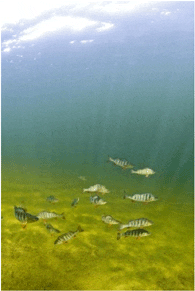The psychiatric drug is used to treat anxiety in humans. But, Oxazepam residues often wind up in natural aquatic systems, downstream from sewage treatment plants, where their effects on ecosystems have been unknown. Now, Brodin and the other researchers have dosed wild perch with amounts of Oxazepam equivalent to those found in Sweden's rivers and streams, and their results suggest that even small amounts of the drug can alter the behavior and the foraging rates of these fish.
The related report appears in the 15 February issue of the journal Science, which is published by AAAS, the nonprofit science society.
"While alone, fish that were exposed to Oxazepam dared to leave safe refuge and enter novel, potentially dangerous areas," explained Brodin. "In contrast, unexposed fish stayed hidden in their refuge. The exposed fish seemed much less stressed and scared, behaving calmer and bolder."

Perch that were exposed to the drug also devoured their food quicker than unexposed fish—a behavioral quirk that the researchers say could alter the composition of species in the water and lead to ecological events, such as increased algal blooming, over time. Since fish are generally integral pieces of their food webs, changes in their eating patterns could disturb ecological balances, according to the researchers.
The fish that were given Oxazepam during the study also became anti-social, distancing themselves from other perch and putting themselves at greater risk of predation. "Perch that were exposed to Oxazepam lost interest in hanging out with the group, and some even stayed as far away from the group as possible," explained Brodin.
The fish in the study accumulated concentrations of the drug in their muscle tissues that were comparable to those found in wild fish, according to the researchers. So it's likely
that the fish in Sweden's surface waters, many of which are being exposed to similarly diluted doses of Oxazepam, may be experiencing changes in their behavior and feeding rates as well, they say.
This study by Brodin and his colleagues singled out a particular psychiatric drug that has been found in natural systems. But, a veritable cocktail of drugs can be found in waterways worldwide, making the discovery of Oxazepam's effects on fish that much more important.
More comprehensive studies are needed before general conclusions can be drawn about how such pharmaceutically induced changes to behavior might affect ecosystems, but these current findings suggest that the concentrations of Oxazepam in Sweden's surface waters could have unexpected ecological and evolutionary consequences over time.
"The solution to this problem isn't to stop medicating people who are ill but to try to develop sewage treatment plants that can capture environmentally hazardous drugs," concluded Jerker Fick, a co-author of the Science report, in a press release from Umeå University.
March 2013




